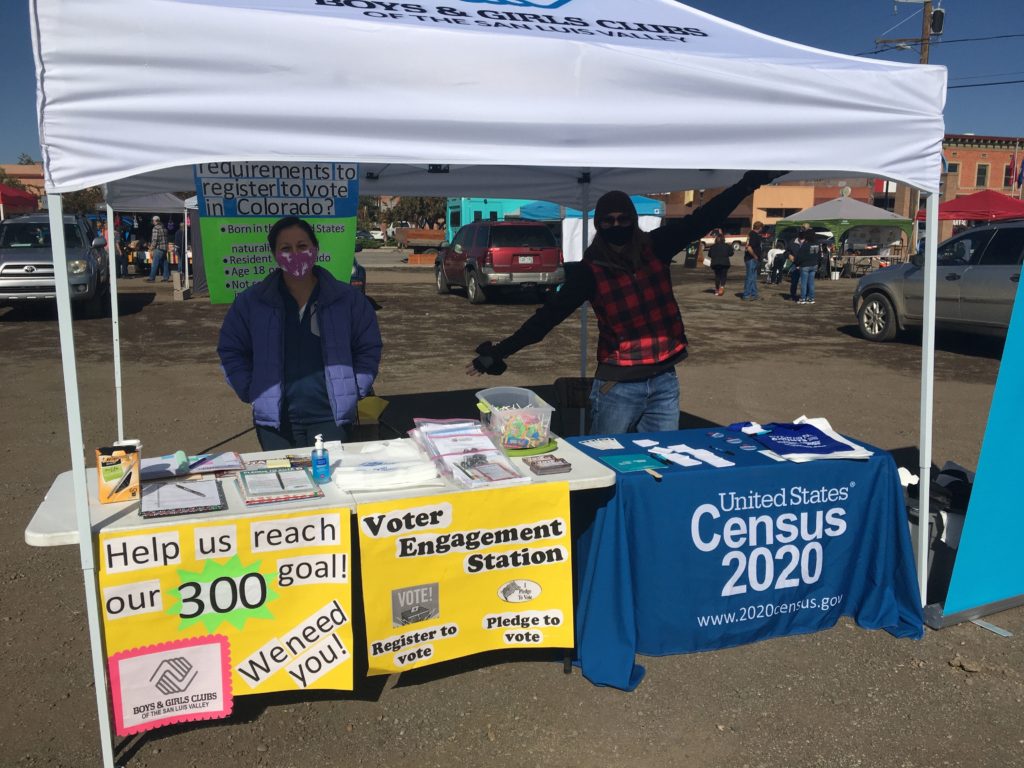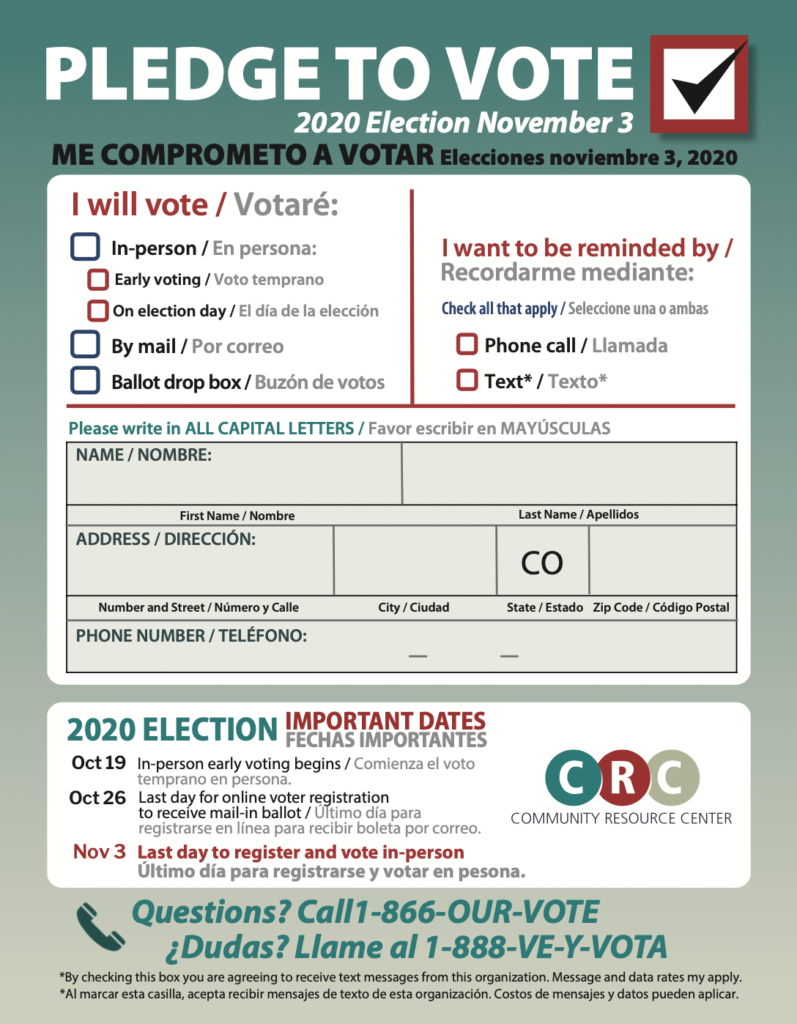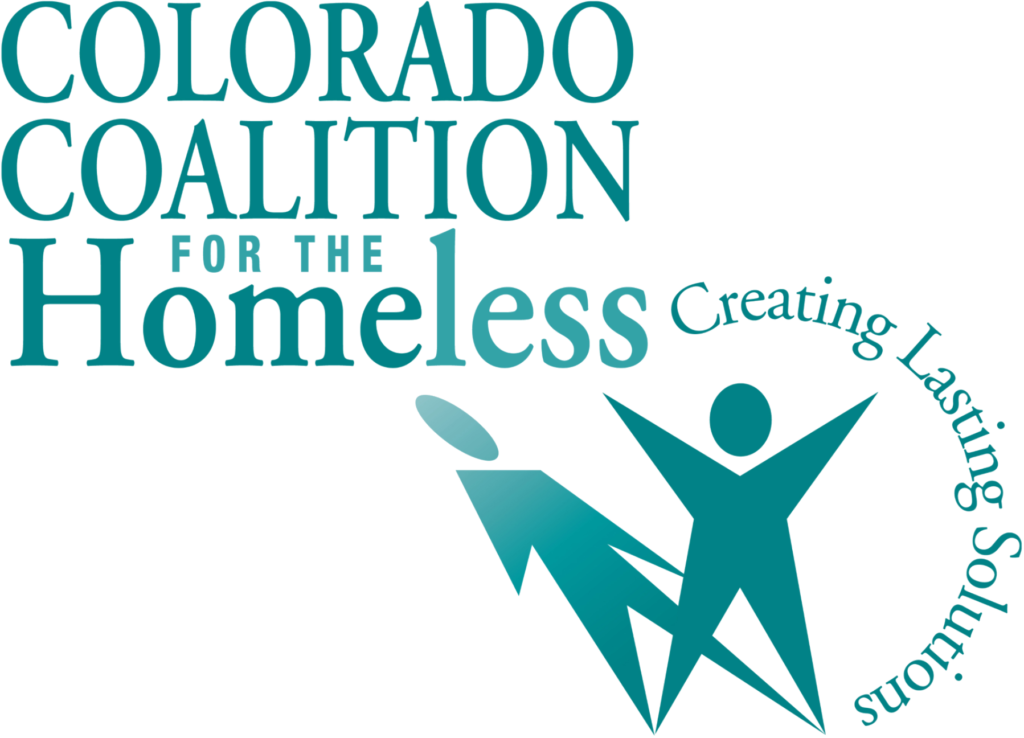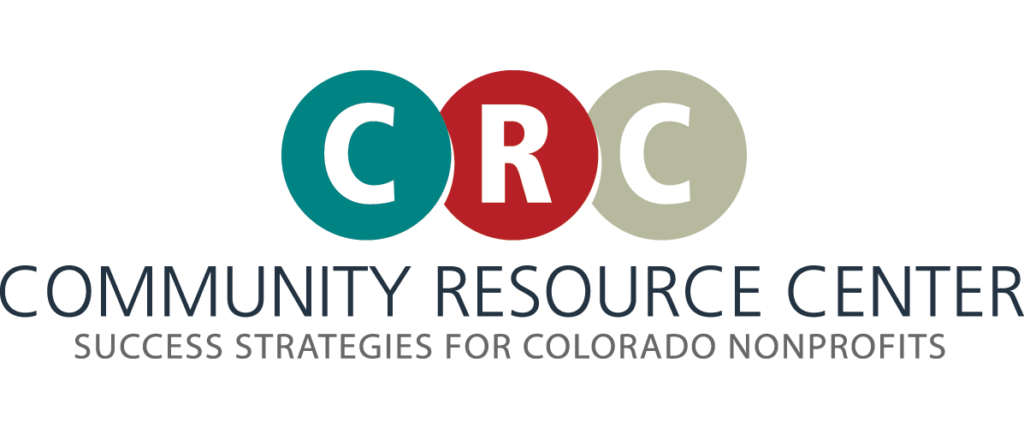
Colorado Participation Project (Community Resource Center)
Community Resource Center (CRC) creates opportunities, tools, and strategies to develop nonprofits and community groups to strengthen Colorado. The Participation Project, founded in 2010 and adopted as a program by CRC in 2015, provides guidance, training, and support to partner nonprofits—food pantries, community health clinics, homeless shelters, and others—to develop effective and realistic action plans for civic engagement. Additionally, the Participation Project trains and manages a cohort of local Organizers that support on-site voter engagement work as needed.

“Often we don’t have our voices heard by elected officials, so by saying we are registered voters gives us more sway and gets people more engaged in the advocacy and political process.”
Aubrey Hasvold, Advocacy Program Director, Colorado Coalition for the Homeless
Collaborating Organizations: The Action Center, The Ark Childcare & Preschool, Boys & Girls Clubs of the San Luis Valley, Boulder Food Rescue, The Center on Colfax, Colorado Coalition for the Homeless, Denver Public Libraries, Emergency Family Assistance Association, Family Resource Center, Harm Reduction Action Center, History Colorado, Kaizen Food Rescue, Latino Community Foundation of Colorado, Manna – The Durango Soup Kitchen, Metro Caring, Mi Casa Resource Center, Mile High United Way – Bridging the Gap, Mountain Family Health Centers, North Fork Valley Public Radio, Peak Vista Community Health Centers, Saint Francis Center, Salud Family Health Centers, Salvation Army, School Community Youth Collaborative, Sister Carmen Community Center, Small Town Project, Sunrise Community Health Centers, Sun Valley Kitchen, and Warren Village
Pledge-to-vote card
In addition to asking people to register to vote, sites used pledge-to-vote cards that were customized for their state and featured the Community Resource Center branding. Important elements of the card include:
- Important dates
- Translated into Spanish
- Plan to vote
- Voter hotlines
Read more about creating pledge-to-vote cards in the Methods section of the Practitioner’s Report.

Site Case Study

About
The Mission of the Colorado Coalition for the Homeless (CCH) is to work collaboratively toward the prevention of homelessness and the creation of lasting solutions for families, children, and individuals who are experiencing or at-risk of homelessness throughout Colorado. CCH advocates for and provides a continuum of housing and a variety of services to improve the health, well-being, and stability of those it serves.
Since its founding more than 30 years ago, the organization has earned state and national recognition for its integrated healthcare, housing, and service programs. The Coalition’s comprehensive approach addresses the causes of homelessness, as well as the consequences, offering critical assistance to over 20,000 individuals and families each year.
Why Colorado Coalition for the Homeless Engages Voters
CCH started engaging voters around 2015. They recognized they could provide voter information and assistance for people experiencing homelessness or housing insecurity at their shelters, medical centers, and at other points of service. They also recognized that legislators are more likely to listen to voters that are registered in their district. Being registered to vote and voting enabled their staff and clients to better advocate for themselves and on behalf of the organization and their community.
Key Successes
As a statewide organization, CCH understood and was able to actively address three important myths and challenges to registering and voting in the 2020 election that affects the people they serve. They utilized in-person strategies like registering people to vote at shelters and virtual strategies to reach people who they were less likely to be able to speak to face-to-face.
Addressing Myths in Voter Engagement
Through their efforts, CCH identified three key myths they had to regularly address with their clients when considering registering or pledging to vote.
The first myth CCH addressed was the belief that a person couldn’t register to vote without a home address. While Colorado voter registration does require a “home address” as part of the form, this address could be the address of the shelter where they were staying or where they return to often to get their mail. This allows voters who are experiencing homelessness to cast a ballot and make their voice heard in elections.
The second common myth CCH addressed was that the potential voter was ineligible to vote because of a former felony conviction. Unless a person is currently incarcerated, they are eligible to vote in Colorado (this includes voters serving parole). However, there’s a lot of misinformation that leads to formerly incarcerated individuals thinking they can’t cast a ballot. When a person said they couldn’t vote because they were formerly incarcerated, CCH was able to give them good news and provide them with assistance.
Another challenge facing CCH clients was clients feeling disenfranchised and like their vote wouldn’t make an impact. These voters have had negative interactions with government agencies and felt let down by the system. Often CCH was able to tie local issues their clients dealt with to voting. For example, Denver voters had a ballot initiative that would “levy an additional 0.25% sales tax-generating an estimated $40 million per year to fund housing and homeless services”.
Connecting what voters cared about with a tangible action they could take, like voting on an initiative that would benefit them, made registering and pledging to vote more relevant.
CCH was able to address these myths and reach voters through a variety of programs. Most notably, they were able to register people to vote in person at shelters. During the COVID-19 pandemic, there were also many temporary emergency shelters put in place at hotels and other appropriate sites. CCH spoke directly with voters where they were staying. They were also able to accommodate the needs of folks at high-risk for COVID by leaving materials at their door and collecting them later or speaking with them over the phone.
As a statewide organization, they also wanted to make sure they engaged members who were in more rural areas, and they can’t engage face-to-face. They used Hustle (a texting platform) and VAN (a database of voters) to hold text and phone banks to reach these voters, answer questions they have, and provide them ways to register or pledge-to-vote via digital platforms.
Overall, CCH found the best way to engage voters was to recognize voters’ needs, what may be holding them back from registering and voting, and meeting voters where they’re at.

